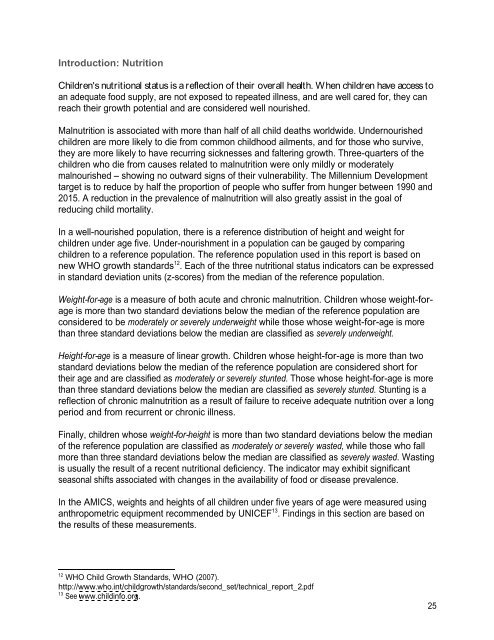Microsoft Word - AMICS-29Jan2013 - Childinfo.org
Microsoft Word - AMICS-29Jan2013 - Childinfo.org
Microsoft Word - AMICS-29Jan2013 - Childinfo.org
Create successful ePaper yourself
Turn your PDF publications into a flip-book with our unique Google optimized e-Paper software.
Introduction: Nutrition<br />
Children s nutritional status is a reflection of their overall health. When children have access to<br />
an adequate food supply, are not exposed to repeated illness, and are well cared for, they can<br />
reach their growth potential and are considered well nourished.<br />
Malnutrition is associated with more than half of all child deaths worldwide. Undernourished<br />
children are more likely to die from common childhood ailments, and for those who survive,<br />
they are more likely to have recurring sicknesses and faltering growth. Three-quarters of the<br />
children who die from causes related to malnutrition were only mildly or moderately<br />
malnourished showing no outward signs of their vulnerability. The Millennium Development<br />
target is to reduce by half the proportion of people who suffer from hunger between 1990 and<br />
2015. A reduction in the prevalence of malnutrition will also greatly assist in the goal of<br />
reducing child mortality.<br />
In a well-nourished population, there is a reference distribution of height and weight for<br />
children under age five. Under-nourishment in a population can be gauged by comparing<br />
children to a reference population. The reference population used in this report is based on<br />
new WHO growth standards 12 . Each of the three nutritional status indicators can be expressed<br />
in standard deviation units (z-scores) from the median of the reference population.<br />
Weight-for-age is a measure of both acute and chronic malnutrition. Children whose weight-forage<br />
is more than two standard deviations below the median of the reference population are<br />
considered to be moderately or severely underweight while those whose weight-for-age is more<br />
than three standard deviations below the median are classified as severely underweight.<br />
Height-for-age is a measure of linear growth. Children whose height-for-age is more than two<br />
standard deviations below the median of the reference population are considered short for<br />
their age and are classified as moderately or severely stunted. Those whose height-for-age is more<br />
than three standard deviations below the median are classified as severely stunted. Stunting is a<br />
reflection of chronic malnutrition as a result of failure to receive adequate nutrition over a long<br />
period and from recurrent or chronic illness.<br />
Finally, children whose weight-for-height is more than two standard deviations below the median<br />
of the reference population are classified as moderately or severely wasted, while those who fall<br />
more than three standard deviations below the median are classified as severely wasted. Wasting<br />
is usually the result of a recent nutritional deficiency. The indicator may exhibit significant<br />
seasonal shifts associated with changes in the availability of food or disease prevalence.<br />
In the <strong>AMICS</strong>, weights and heights of all children under five years of age were measured using<br />
anthropometric equipment recommended by UNICEF 13 . Findings in this section are based on<br />
the results of these measurements.<br />
12<br />
WHO Child Growth Standards, WHO (2007).<br />
http://www.who.int/childgrowth/standards/second_set/technical_report_2.pdf<br />
13<br />
See www.childinfo.<strong>org</strong>.<br />
25

















